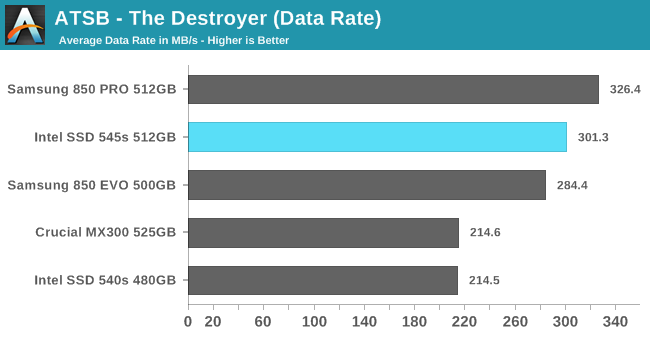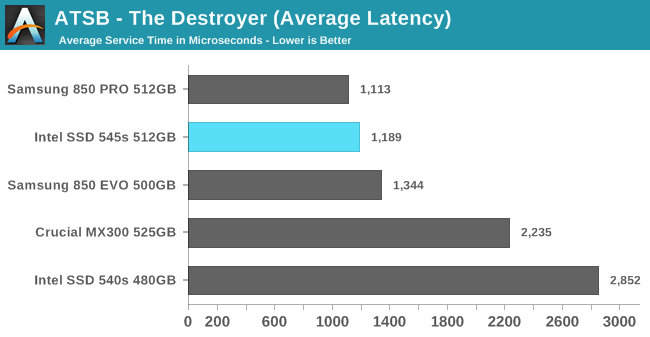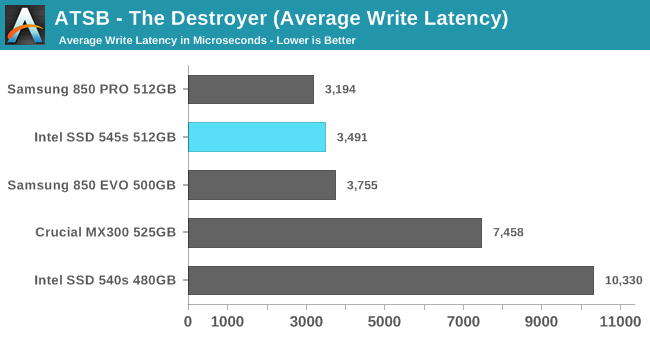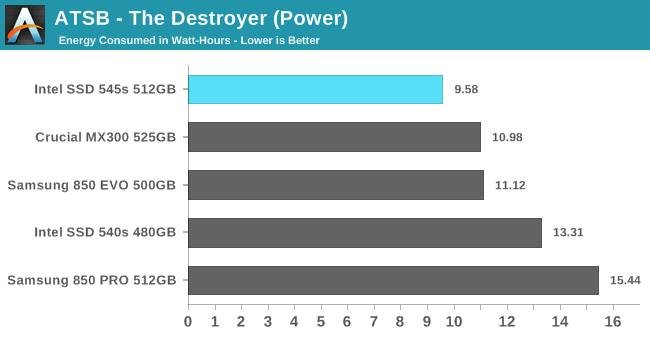The Intel SSD 545s (512GB) Review: 64-Layer 3D TLC NAND Hits Retail
by Billy Tallis on June 27, 2017 6:00 AM ESTAnandTech Storage Bench - The Destroyer
The Destroyer is an extremely long test replicating the access patterns of very IO-intensive desktop usage. A detailed breakdown can be found in this article. Like real-world usage, the drives do get the occasional break that allows for some background garbage collection and flushing caches, but those idle times are limited to 25ms so that it doesn't take all week to run the test. These AnandTech Storage Bench (ATSB) tests do not involve running the actual applications that generated the workloads, so the scores are relatively insensitive to changes in CPU performance and RAM from our new testbed, but the jump to a newer version of Windows and the newer storage drivers can have an impact.
We quantify performance on this test by reporting the drive's average data throughput, the average latency of the I/O operations, and the total energy used by the drive over the course of the test.

The Intel SSD 545s performs surprisingly well on The Destroyer, with an average data rate that surpasses the Samsung 850 EVO and potentially makes the 545s the new fastest SATA SSD with 3D NAND. The 3D MLC-based Samsung 850 PRO is still out of reach, but the 545s is a big improvement over the 540s and the Crucial MX300.

The Intel 545s also ranks between the Samsung 850 PRO and 850 EVO in terms of average latency, with slightly more than half the latency of the Crucial MX300 and an even wider margin over the Intel 540s.


Separating the latency according to reads and writes, we see that the 545s is much closer to the Samsung 850 PRO than the 850 EVO for reads. The write latencies of the Samsung drives and the 545s are all much lower than the Crucial MX300 or Intel 540s.

In addition to delivering great performance for a SATA TLC SSD, the Intel 545s brings a huge improvement in power efficiency. The 545s uses 12% less energy than the Crucial MX300 or Samsung 850 EVO over the course of the test. Only a few SSDs have ever completed The Destroyer on such a small energy budget, and only one other TLC SSD has been this efficient.










74 Comments
View All Comments
jjj - Tuesday, June 27, 2017 - link
Thanks for the details.Guess with this launch, we'll soon have confirmation that they are using string stacking.
jjj - Wednesday, June 28, 2017 - link
Seen this? https://www.wdc.com/about-wd/newsroom/press-room/2...Flashguru - Saturday, July 8, 2017 - link
So you had the Toshiba NVMe 64layer drive first but bumped it from your testing so you could announce Intel was first to market?JimmiG - Tuesday, June 27, 2017 - link
Great to see some competition for the 850 Evo. Kind of ironic that it should come from Intel, who aren't usually known as the underdogs that provide much needed competition...jimjamjamie - Tuesday, June 27, 2017 - link
"On some tests, the Intel 545s appears to be the first serious challenger to the Samsung 850 EVO's combination of high performance and good power efficiency in a TLC SATA SSD."Well now I'm interested. Fingers crossed for decent pricing.
MajGenRelativity - Tuesday, June 27, 2017 - link
Definitely, if it can come under the 850 Evo, I'll have my eye on this drive.halcyon - Tuesday, June 27, 2017 - link
Oh Intel, how far have you fallen. You used to be the innovator, the forerunner.Now you're playing catch up and barely managing at that.
What happened?
jimjamjamie - Wednesday, June 28, 2017 - link
They realised it was more profitable to sell tiny dual and quad core CPUs for hundreds of dollars, add a pin to the socket every few years to sell a new chipset, and add 100MHz to the top end model and sell it for an extra thousand dollars.Retycint - Monday, July 3, 2017 - link
And add four extra cores for more than twice the price of the original. The X series of CPUs and chipsets were completely scams, up until Ryzen happened.Rictorhell - Tuesday, June 27, 2017 - link
Any idea, at all, on what form factors the m.2 versions will be available in, at launch, or the possible capacities that will be available for those form factors?